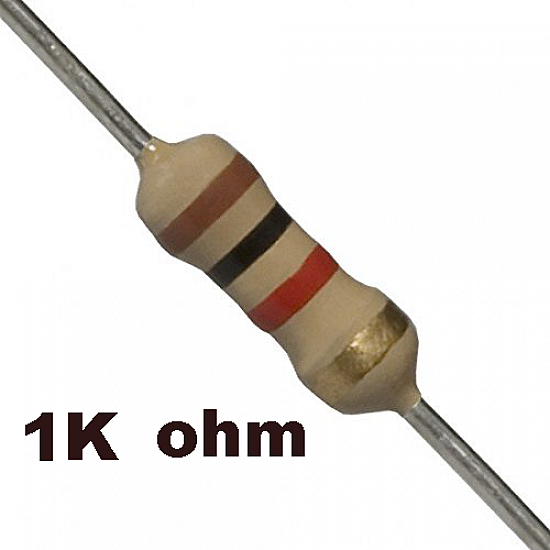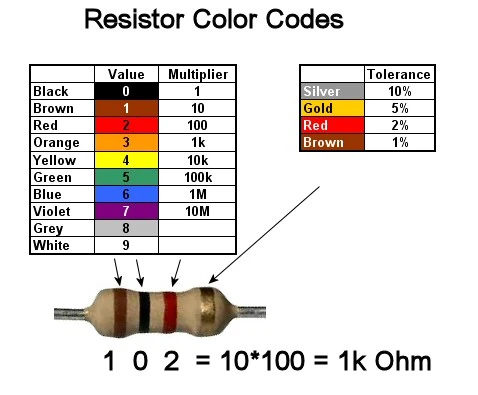A 1k resistor is a resistor with a resistance value of 1 kilohm, which is equivalent to 1000 ohms. The "k" in 1k stands for "kilo," which denotes a factor of 1000. Here are some key points about a 1k resistor:

Characteristics of a 1k Resistor:
- Resistance Value: A 1k resistor has a resistance of 1000 ohms or 1 kilohm (1kΩ).
- Color Coding: In through-hole resistors, the color bands on a 1k resistor may be brown, black, red, and gold/silver, where brown represents the digit 1, black represents 0, red represents a multiplier of 100 (2 zeros), and gold or silver represents the tolerance.
- Power Rating: The power rating of a 1k resistor indicates the maximum power it can dissipate without damage. Common power ratings for resistors include 1/4W, 1/2W, 1W, etc.
- Tolerance: The tolerance of a 1k resistor determines the range within which the actual resistance may vary from the stated value. Tolerances are typically expressed as a percentage (e.g., ±5%, ±1%).
- Applications: 1k resistors are widely used in electronic circuits for various purposes such as voltage dividers, current limiting, biasing components, LED current limiting, and general signal conditioning.
Usage of 1k Resistors:
- Voltage Divider: 1k resistors are commonly used in voltage divider circuits to generate reference voltages or as biasing components.
- Current Limiting: They can be used to limit current in LEDs or other components to prevent damage due to excessive current flow.
- Pull-up or Pull-down Resistors: 1k resistors are suitable for pull-up or pull-down configurations in digital circuits to ensure well-defined logic states.
- Signal Conditioning: They are used for signal conditioning, filtering, and biasing in various analog and digital circuits.
- Biasing and Loading: 1k resistors can be used for biasing transistors, loading capacitors, and setting operating points in amplifier circuits.
Summary:
- A 1k resistor has a resistance value of 1000 ohms or 1 kilohm.
- It is widely used in electronic circuits for voltage division, current limiting, biasing, and signal conditioning.
- Understanding the specifications and application of 1k resistors is crucial for designing and building electronic circuits effectively.

1k Resistor Color Code
In the color band notation system used for through-hole resistors, a 1k ohm resistor is typically represented by the following color bands:
- First Band (Digit): Brown
- Second Band (Digit): Black
- Third Band (Multiplier): Red
- Fourth Band (Tolerance): Gold or Silver
Therefore, a 1k ohm resistor would have the following color code:
- Brown, Black, Red, Gold (or Silver)
In this code:
- Brown represents "1"
- Black represents "0"
- Red represents a multiplier of 100 (10^2)
- Gold or Silver represents the tolerance (typically ±5% for general-purpose resistors)
This color code is used to quickly identify the resistance value and tolerance of resistors, making it easier for users to select and work with resistors in electronic circuits.
| Color | Digit | Multiplier | Tolerance |
| Brown | 1 | 10^0 | - |
| Black | 0 | 10^1 | - |
| Red | - | 10^2 | - |
| Gold | - | - | 5% |
Applications of 1k Resistor
A 1k ohm resistor (1000 ohm resistor) is a commonly used resistor with a resistance value of 1 kilo-ohm. Here are some common applications of a 1k resistor:
1. Voltage Divider:
- Used for Signal Processing: In voltage divider circuits, a 1k resistor can help generate a fraction of the input voltage, which is useful in signal processing applications and for setting reference voltages.
2. Current Limiting:
- LED Circuits: In LED circuits, a 1k resistor can be used to limit the current flowing through an LED, preventing it from drawing excessive current and getting damaged.
3. Pull-up and Pull-down Resistors:
- Digital Electronics: In digital electronics, a 1k resistor is commonly employed as a pull-up or pull-down resistor in logic circuits to ensure that the input signal to a device settles at a known state in the absence of an input signal.
4. Biasing:
- Transistors and Operational Amplifiers: A 1k resistor is often used in biasing circuits for transistors and operational amplifiers to set the operating point and ensure proper bias conditions for optimal circuit performance.
5. Timing Circuits:
- RC Circuits: In combination with capacitors, a 1k resistor is used in timing circuits to control the rate at which a capacitor charges or discharges, influencing the timing characteristics of the circuit.
6. Voltage Dropping:
- Voltage Regulation: In certain circuits, a 1k resistor can be utilized to drop the voltage from a power supply to a desired level for specific components.
7. Filtering:
- High-Frequency Circuits: In conjunction with capacitors, 1k resistors are used in high-pass and low-pass filter circuits to shape frequency responses and filter out unwanted noise or frequencies.
Note:
- The applications mentioned above are just a few examples of the versatile uses of 1k resistors in various electronic circuits.
- When selecting a 1k resistor for an application, consider the power rating, tolerance, and type (such as carbon film, metal film, or other types) based on the specific requirements of the circuit.
The 1k resistor is a fundamental component in electronics design, widely used in both analog and digital circuits to control current, voltage levels, and signal processing. Its versatility and reliability make it a fundamental building block in circuit design across a range of applications.




